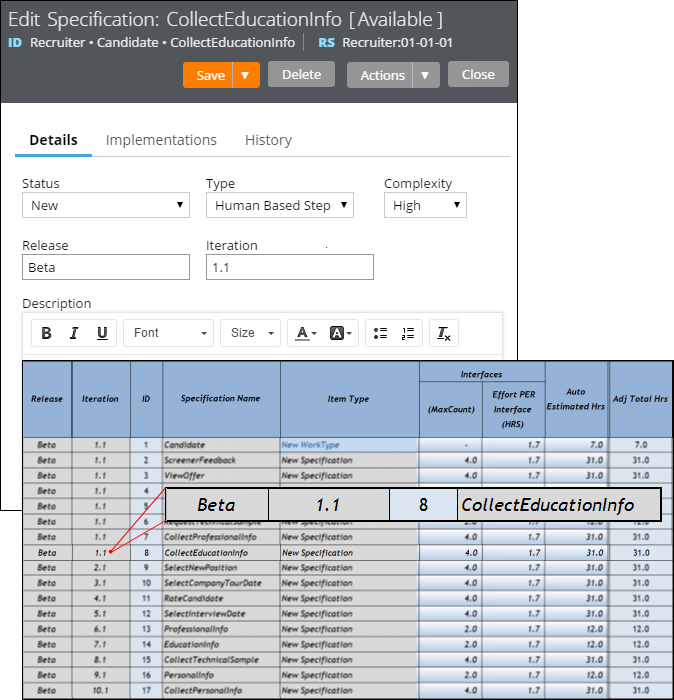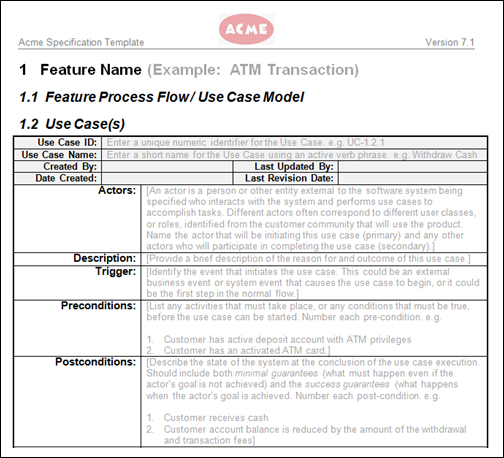Tracked changes persist between client sessions
Valid from Pega Version 7.1.7
The Microsoft Word native change tracking feature persists between client sessions for specifications. Enable this feature to facilitate collaborative reviews of your specifications with project stakeholders.
Inserting your specification updates as tracked changes allows you to:
- Provide visible markup to the next reviewer.
- Correlate edits to a specific user and time.
- Generate documents that include markup and comments.
Local settings, such as the colors you specify for markup, do not persist between clients.
For instructions on how to prevent markup and comments from appearing in generated documents, see Advanced options for editing specifications.
Add multiple attachments at once
Valid from Pega Version 7.1.7
You can now add more than one attachment to a requirement or specification at a time, without closing the Add/Edit Attachment modal dialog box. Use the traditional browse method to upload an attachment or drag and drop a local file, based on your needs. View and access your attachments from the Application Profile landing page, Requirement form, or Specification form.
Plan projects using release data
Valid from Pega Version 7.1.7
Requirements and specifications can now be mapped to a target release and iteration within a specific release. Populating these fields allows you to set and publish a release schedule through worksheets generated by the Sizing wizard. Access these fields from the Application Profile landing page or by opening any requirement or specification.

The Release and Iteration fields as they appear in a specification and a corresponding worksheet
The Sizing wizard incorporates values from the Release and Iteration fields for specifications only.
Specification type extended for decisioning users
Valid from Pega Version 7.1.7
Specifications now support a Decision Strategy Manager (DSM) type. This allows you to map your specifications to a decisioning component, such as a strategy or model. After you select an appropriate subtype and provide relevant metadata, you can run the Sizing wizard to incorporate these details into project sizing worksheets.

DSM specification details as they appear in the Specification form and Sizing wizard output
You must have access to Decision Management rulesets to create DSM specifications. For more information on specification types, refer to the Details tab of the Specification form. To view all specifications in your application, filtered by type, refer to the Application Profile landing page.
Add collections as linked implementations
Valid from Pega Version 7.1.7
You can now identify a collection or individual steps within a collection as an implementation of a specification. Linking specifications to rules allows you to more accurately convey your application design to project stakeholders. Use the Specifications tab on the Collection form to create these links.
To see all implementations for a given specification, refer to the Application Profile landing page or the Implementations tab of the Specification form.
Add project branding to generated documents
Valid from Pega Version 7.1.7
The standard Word Template for specification descriptions is now extensible. Using a customized template allows you to brand your generated documents with project-specific elements.
Specialize the Rule-Application-UseCase.pySpecificationDescription rule to:
- Include relevant images such as company logos.
- Define static text.
- Insert dynamic elements by merging clipboard values into field codes.

Generated document with custom company logo
Refer to Advanced options for editing specifications for instructions on how to override this template.
Enhanced reliability and stability of scenario tests
Valid from Pega Version 8.5
Several enhancements have been made to scenario tests to increase their stability and reliability. With enhanced improvements, you can now:
- Delay the execution of a step within a scenario test to add latency to a web browser and actions on a web page. This prevents tests from failing when a dynamic web page does not load all page element at once, but the test finds page elements that are immediately rendered.
- Automatically rerun failed scenario tests, which might fail because there are temporal stability issues on the environment or because the application UI is slowly renders.
- View the run history of scenario tests so that you can analyze the history of a test over time.
For more information, see the following:
- Delay the execution of a step within a test and rerun failed scenario tests for enhanced scenario test stability (8.5)
- Changing application quality metrics
- Automatically rerunning failed scenario tests
- Creating scenario tests
Scenario tests now honor application stack settings
Valid from Pega Version 8.5
The application stack defined on the Application Quality Settings page of Dev Studio now serves as a foundation for creating, viewing, and running scenario tests.
Dev Studio will now:
- Display scenario tests based on the application stack settings on the Dev Studio landing page.
- Store scenario tests with the configured stack settings.
- Report metrics in the application quality dashboard with respect to the configured stack settings.
For more information, see Creating UI-based tests with scenario testing.
Run an application test suite from a CI/CD pipeline
Valid from Pega Version 8.5
Deployment Manager, as well as the existing REST service used to call scenario tests, now accepts a test suite ID when running scenario tests from an application pipeline. By using test suites, you can customize a set of select scenario tests to run as a group, instead of running all the scenario tests that are applied to a particular application.
Only the tests that belong to the suite are run as part of the task.
For more information, see Creating UI-based tests with scenario testing.
Access PegaUnit compliance metrics from a centralized location
Valid from Pega Version 8.5
PegaUnit compliance metrics and execution rate have been added to the PegaUnit metrics tile of the Application Quality dashboard. This dashboard provides a centralized location for all PegaUnit data for a specific application.
The dashboard also supports granular PegaUnit test information for each case type and data type, similar to the process currently available on the branch quality dashboard.
For more information, see Analyzing application quality metrics.

